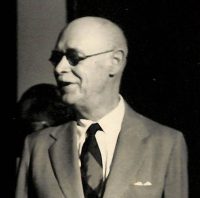At noon to Capitol with General Valdes and Colonel Andres Soriano. Valdes says he is going back to service in Australia next week.
I felt much like a stray cat on the floor of the House of Representatives–had not entered the Chamber since in August 1913 I left after nine years of service there to go to the Philippines. I recognized only two of the old members who were there in my time. The representatives looked rather depressed. Elizalde tells me that they know they have their authority and power to the Executive; and feel very much the bitter and frequent attacks on them by the “smear” press.
When Quezon mounted the Speaker’s dais he made a striking figure outlined against the huge American flag–shoulders squared and head thrown back. His eyes sparkled and his person gave out a spirit of animation and vitality, quite in contrast to the rather weary, not to say depressed looking figures of the members of the House.
He received an ovation, and prolonged applause punctuated his address. He read the cablegram to him at Corregidor from President Roosevelt promising the re-occupation of the Philippines, the giving of independence and, most important, the protection of it. Gave the impression that it was these promises which inspired the Filipinos to their gallant stand at Bataan. Altogether an impressive and useful speech. The occasion was one of real drama. He lived up to it.
Afterwards, we spent an hour “revising” or correcting the official stenographic report of his speech, as is customary before an address in the House of Representatives goes to the government printing office for the Congressional Record.
“Baby” Quezon to whom, in an aside, I confided my fear at the time that Quezon’s voice would give out in the middle of his address, replied: “Oh, Father’s voice never gives out unless he finds it expedient.”
Driving back from the Capitol alone with Quezon, I found him too tired for conversation, until I mentioned by chance the subject of the Philippine Moros. I commented upon the sad end of former Governor Fort of Jolo, who had been an appointee of Governor General Wood. After resigning his post in 1937 he became a Protestant Episcopal missionary in Cotobato–another unruly Moro section. One morning on a path near there, his body was found on the path with the head severed by the blow of a bolo.
Quezon remarked that the Moros really like nobody whatever but themselves, except when they can get something out of it. “That,” he said, “was a fact which no Americans had discovered”; in Australia this Spring even General MacArthur had told him of the great use we were going to make against the Japanese of the enthusiasm of the Philippine Moros for the American cause. Quezon told him, however, that he hoped the American Army was not going to give arms to the Moros on Jolo, who are reported to have joined the Japanese, but added that the Japs will have plenty of trouble with them. “Jolo,” Quezon added, “is divided into two factions each claiming a Sultan.” (As I think this split was brought about by Quezon himself, in order to weaken the power of the Joloano Sultanate, I made no comment.) Quezon further remarked that when he reached Mindanao on his journey of escape from Corregidor, the American Army officers there were boasting of the great help the Moros were about to give them. Quezon laughed.
He then turned to the subject of the war against Japan: He said it could not be won without “the complete destruction of their army and navy–that with such a government and such a people, a negotiated peace would be utterly impossible.
In the Shoreham grill-room I met Harry T. Edwards, one of my former Bureau Chiefs as Director of Agriculture. He is now and for years has been fibre expert in the United States Department of Agriculture. He first came to the Philippines shortly after the Insurrection was over, but says many Filipinos in the provinces kept on fighting until about 1904. Even then, there was a raid by them on Cavite when he was visiting his brother there. He told me that General MacArthur, the father of our General, who was the last Military Governor of the Philippines was very “stuffy” about turning over the reins of power to the first Civil Governor, William Howard Taft, and kept the latter waiting at the door of his office in Fort Santiago for an hour before admitting him to take over. Taft never forgave MacArthur. So ended the “Days of the Empire,” except in Mindanao and Sulu where the army officers still refer to the Philippine administration in Manila as the “Civil Government.” The singing by Army Officers at their annual “Carabao Wallow” of the song “Damn, damn, damn the Filipinos” continued until 1913, when after my arrival in the Philippines, President Woodrow Wilson ordered that to cease.
Had a conversation with Resident Commissioner “Mike” Elizalde at his office this afternoon. He has great and sincere admiration for President Quezon. Thinks Osmeña would be of no use except to hand out the offices, and that he could not run a government himself. (This in my opinion is a gross underestimation of Osmeña’s abilities.) Elizalde says the Filipinos were all right under American Governors General, but queries how they will make out by themselves when solving such problems as government finance. He esteems Quezon highly because when he is not “up” on a subject himself he is willing to take advice; says he was called in with Yulo and others to give opinion as to whether Quezon should accept a second term as President of the Commonwealth. He was the only one consulted who answered “no,” because he is such a confirmed democrat and believes the other system leads to dictatorship. Thinks well of Manuel Roxas as an eventual successor to Quezon.
